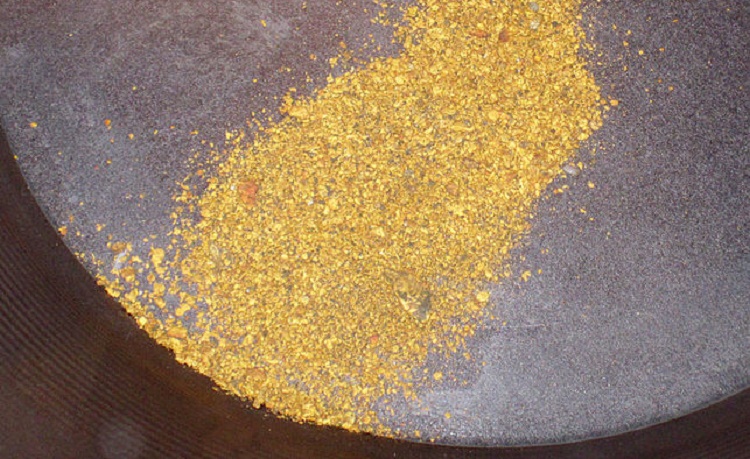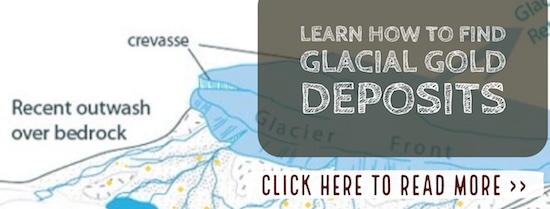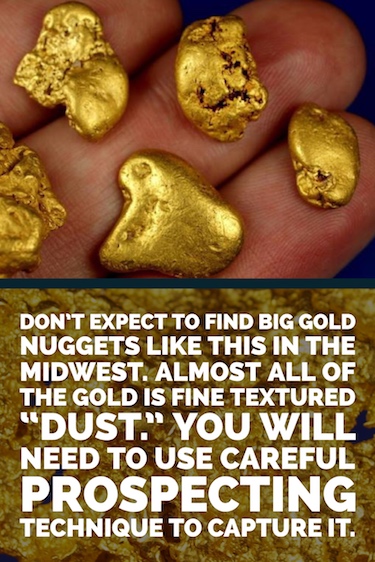What is Glacial Gold?

During the five major Ice Ages which occurred over millions of years, glaciers expanded far away from the north pole to cover a significant part of the earth. In North America the glaciers moved far enough south to cover most of the northern states in the US. During their travels, glaciers moved huge amounts of anything that stood in their path. The gigantic piles of debris included, along with everything else, you guessed it, gold.
When the glaciers eventually retreated, some of the material left behind had been moved hundreds of miles. Glacial gold can truly be anywhere, but it will still concentrate in certain areas just like all placer gold does.
Where Can You Find Glacial Gold Deposits
Glacial gold is found in all the New England States, New York, Pennsylvania, Ohio, Michigan, Indiana, Illinois, Wisconsin, Iowa, Minnesota, Missouri, Kansas, Nebraska, and the Dakotas. While some of these states contain native gold deposits, many of them have little or no natural gold.
The ice sheets, which could also be called the planet’s greatest natural miners, brought this precious metal great distances. If you plan to go hunting for glacier gold, first check out state or regional glaciation books (yes, they really do exist). If glaciers never made it to an area, glacial gold didn’t either.
Mostly Scattered, Small Specks of Gold
The overall concentration of the gold left behind by glaciers tends to be is much lower than you what you might find in places that produces gold naturally, such as the Alaska or the Western US.
The placers in the West tend to be rather close to the gold veins where they began. In contrast, glacial gold deposits were transported over incredibly great distances. As the glaciers retreated the gold left behind was distributed so widely across the landscape that very few areas got appreciable amounts of gold in any one area. As a result, there are few profitable gold mines to be found in this part of the continent.
As might be expected considering the way it was crushed and scraped by the massive ice sheets, most glacial gold is very fine. Except for a few areas, the only way to recover glacial gold deposits is by using specialized techniques used to recover the gold dust found in other types of placers.
Use a specialized sluice box, Gold Cube Concentrator, or other gear designed for fine gold if you have it or be prepared to spend a lot of time carefully panning to recover any decent amounts of gold. Despite the very few commercially viable concentrations, collectors can find a little gold, if you know how to work glacial placers. Just consider prospecting there a hobby that may cover its costs if you are lucky and very patient.
Glacial Placer Deposits
Although glaciers bulldozed everything in their path and left the gold dust behind wherever they retreated from, the gold didn’t just stay in place for millions of years. Just like everywhere else, it will have been moved by streams and rivers, where the heavier materials, such as black sand and gold, will have fallen to the bottom. However, these layers of material are usually not on the surface, but usually at least a few inches underground although they may not reach all the way to bedrock. Sometimes a false clay bedrock is enough to concentrate the gold.

Historic Gold Mining in the Midwest
 Since the early 1850s, it has been known that placer gold could be found in the creeks and rivers of the Midwest. In fact, small amounts of gold can be found not only all across the upper Midwest but also in places from Iowa and Nebraska all the way to the northeast. Ironically, or maybe not surprisingly since they had been searching all along, miners returning home from the California Gold Rush were among the first to make these discoveries in Indiana, Ohio and Illinois.
Since the early 1850s, it has been known that placer gold could be found in the creeks and rivers of the Midwest. In fact, small amounts of gold can be found not only all across the upper Midwest but also in places from Iowa and Nebraska all the way to the northeast. Ironically, or maybe not surprisingly since they had been searching all along, miners returning home from the California Gold Rush were among the first to make these discoveries in Indiana, Ohio and Illinois.
The black sands they discovered in the ditches and creeks of their homeland was more than enough inspiration to motivate at least a few of these hardy individuals to do some sample panning. By the early 1900s, this led to a minor interest in gold prospecting in several states. There were also a few poorly conceived commercial ventures which by the very nature of glacial gold were mostly doomed to failure.
Read: Commercial Placer Mining in the United States
Private Land and Annoying Regulations…
In addition to the challenges posed to gold prospectors by mother nature, there are other challenges that are less common in the West. For one thing. there is a comparatively small amount of public land in the Midwest. Without public lands on which to file claims, small scale gold prospectors are not afforded the protection of the federal Mining Law of 1872, as small-scale miners are out West. The people in the Midwest are often hampered by the whims of state governments and bureaucratic agencies.
In Wisconsin and Michigan, this has led to a virtual ban on any kind of serious suction dredging for gold. In New York State, the government (not surprisingly) is trying to make a claim on any gold found by prospectors, as all minerals technically belong to the state according to New York state law.
Despite the many natural and man-made challenges of mining for often comparatively lower quality gold, that fascinating yellow metal still attracts fortune seekers. Careful exploration of creeks and rivers throughout the Midwest will often turn up small amounts of gold for the diligent prospector.
Next: Find More Gold by Removing Overburden & Expose Bedrock







